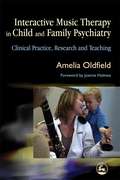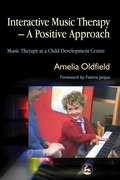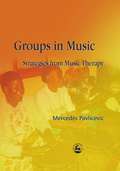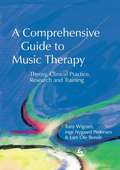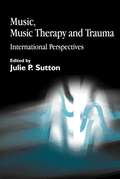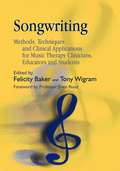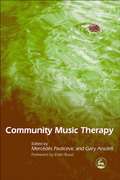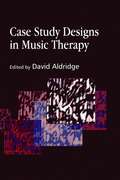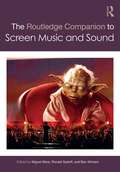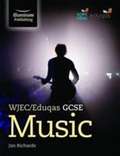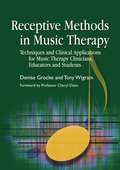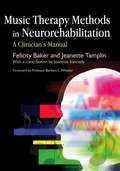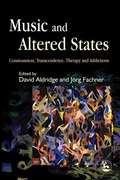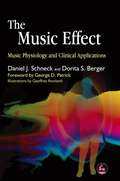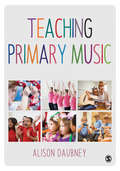- Table View
- List View
Interactive Music Therapy in Child and Family Psychiatry: Clinical Practice, Research and Teaching
by Jo Holmes Amelia Oldfield'What is truly distinctive about this book is that Oldfield introduces her doctoral research, in which she created the Music Therapy Diagnostic Assessment (MTDA) in comparison to one of the most internationally recognized standardized diagnostic tool.' - Autism Diagnostic Observation Schedule (ADOS). 'I believe that the book will be useful for music therapy students, and novice music therapist working in child and family psychiatry and related fields.' - Nordic Journal of Music Therapy 'In her indomitable, accessible and straightforward style, Amelia Oldfield continues to champion the use of music therapy with families in her most recent publication. The book is in many ways a step-by-step music therapy manual, informing us of music therapy methods and innovations and provoking new thoughtfulness for work within the child mental health setting.' - Journal of Family Therapy 'This book could be an invaluable resource for readers who are looking for evidence that music therapy can have a very positive effect on certain disorders and family dynamics. I could imagine it would bring great hope for those whose children find communication very difficult, or where families are struggling to relate emotionally. The book [also] has a lot of clinical research data, which would be extremely useful for students or clinicians needing to validate this kind of work.' - ACCord Magazine 'This practical book outlines and explains the rationale for using music therapy in child and family psychiatry. Amelia Oldfield reflects on current research methodology and describes characteristics of her own approach to therapy sessions, including how to start and end the session, how to motivate children and establish a positive musical dialogue with them, and how to include parents in the session. She also uses video analysis techniques to assess and advance the role of the therapist. Individual chapters focus on the results of the author's research investigations with specific groups such as mothers and young children, groups of adults with profound difficulties, children with autistic spectrum disorder or severe physical and mental difficulties, as well as children without clear diagnosis. Case studies and vignettes supplement these examples. The author also considers the whole process from the initial referral for therapy and using psychiatric music therapy for diagnostic assessment to how to end treatment. This book is accessible to music therapists, psychiatrists, nurses and occupational therapists working with children and families, as well as music therapy trainers, their students and academics interested in music therapy.' - British Society for Music Therapy 'Those who are specifically interested in music therapy as applied to children and families will find no better mentor than Oldfield.' - Mental Health Care Practice 'Well, this book was a pleasant surprise! I found it a remarkably uplifting read. Amelia Oldfield describes in detail how she has managed to interact through music with children (and adults) with a wide range of significant difficulties, intellectual, emotional and physical. Her music therapy is intended to help with diagnosis but she also involved parents and carers in her sessions in a way which helps them to come to terms with and deal more comfortably with their charges.' - Adoption.net This practical book outlines and explains the rationale for using music therapy in child and family psychiatry. Amelia Oldfield reflects on current research methodology and describes characteristics of her own approach to therapy sessions, including how to start and end the session, how to motivate children and establish a positive musical dialogue with them, and how to include parents in the session. She also uses video analysis techniques to assess and advance the role of the therapist. Individual chapters focus on the results of the author's research investigations with specific groups such as mothers and young children, groups of adults with profound difficulties, children with autistic spectrum disorder or severe phy...
Interactive Music Therapy - A Positive Approach: Music Therapy at a Child Development Centre
by Fatima Janjua Amelia OldfieldIn Interactive Music Therapy - A Positive Approach, Amelia Oldfield explains how her approach to music therapy sessions establishes a constructive musical dialogue with children that emphasises positive experiences - these establish trust and allow feelings to be expressed through music. Describing the general benefits of this approach, the author also details its application for specific clinical groups including children with autistic spectrum disorders, relationship difficulties or physical disabilities. Individual chapters focus specifically on child development issues and in child and brief case studies throughout the text illustrate points of particular importance. This practical book will be of use to other clinicians and teachers working with children with a variety of needs, including children on the autism spectrum and children with learning disabilities. It is also of use to music therapy trainers, their students and academics whose interests include music therapy.
Groups in Music: Strategies from Music Therapy
by Mercedes PavlicevicMusic in Groups happens all the time: in the street, the classroom, in music colleges, community centres, hospitals, prisons, churches and concert halls; at raves, weddings, music festivals, public ceremonies, music therapy sessions, group music lessons, concerts and rehearsals. Some group musicking seems to 'work' (and play) better than others; some sessions feel exhausting even if things are going well; and at other times, we can't begin to explain the complex musical and relational textures of group music work to funders, employers, friends, colleagues, or line managers. In this book, music therapist Mercédès Pavlicevic develops a broad-based discourse to describe, analyse and guide the practice of group musicking, drawing on her own extensive experience. The text is illustrated with vignettes drawn from a range of formal and informal settings that include spontaneous public occasions, collective rituals, special and mainstream education, music therapy, the concert hall, the music appreciation group and community work. This book makes you think about balancing individual and group needs, the development of group time, dealing with over-enthusiastic performers who 'hog' the group sound, undercurrents in music groups, the complications of dealing with institutions, preparing music listening programmes and buying instruments for group work - if you're involved in any kind of group musicking, this book is for you.
A Comprehensive Guide to Music Therapy: Theory, Clinical Practice, Research and Training
by Tony Wigram Lars Ole BondeMusic therapists, as in medical and paramedical professions, have a rich diversity of approaches and methods, often developed with specific relevance to meet the needs of a certain client population. This book reflects the many components of such diversity, and is a thoroughly comprehensive guide to accessing and understanding the ideas, theory, research results and clinical outcomes that are the foundations of this field. Providing a detailed insight into the field of music therapy from an international perspective, this book enables the reader to see the complete picture of the multifaceted and fascinating world that is music therapy.
Music, Music Therapy and Trauma: International Perspectives
by Diane Snow Austin Julie SuttonMusic communicates where words fail, and music therapy has been proven to connect with those who were thought to be unreachable, making it an ideal medium for working with those who have suffered psychological trauma. Music, Music Therapy and Trauma addresses the need for an exploration of current thinking on music and trauma. With chapters written by many of today's leading specialists in this area, music and trauma is approached from a wide range of perspectives, with contributions on the following: * neurology of trauma and music; * music and trauma in general; * social and cultural perspectives on trauma; * contextualising contemporary classical music and conflict; * music and trauma in areas where there is war, community unrest and violence (Northern Ireland, Bosnia-Herzegovina, South Africa); * music, trauma and early development. Including specific examples and case studies, this book addresses the growing interest in the effects of trauma and how music therapy can provide a way through this complex process.
Songwriting: Methods, Techniques and Clinical Applications for Music Therapy Clinicians, Educators and Students
by Emma Davies Tony Wigram Lucanne Magill Jeanette Kennelly Felicity Baker Jeanette Tamplin Amelia OldfieldThis comprehensive and groundbreaking book describes the effective use of songwriting in music therapy with a variety of client populations, from children with cancer and adolescents in secondary school to people with traumatic brain injury and mental health problems. The authors explain the specific considerations to bear in mind when working with particular client groups to achieve the best clinical outcomes. All the contributors are experienced music therapy clinicians and researchers. They provide many case examples from clinical practice to illustrate the therapeutic methods being used, together with notated examples of songs produced in therapy. Particular emphasis is placed on how lyrics and music are created, including the theoretical approaches underpinning this process. This practical book will prove indispensable to students, clinical therapists, music therapists, educators, teachers and musicians.
Community Music Therapy
by Mercedes Pavlicevic Gary AnsdellMusic therapists from around the world working in conventional and unconventional settings have offered their contributions to this exciting new book, presenting spirited discussion and practical examples of the ways music therapy can reflect and encourage social change. From working with traumatized refugees in Berlin, care-workers and HIV/AIDS orphans in South Africa, to adults with neurological disabilities in south-east England and children in paediatric hospitals in Norway, the contributors present their global perspectives on finding new ways forward in music therapy. Reflecting on traditional approaches in addition to these newer practices, the writers offer fresh perceptions on their identity and role as music therapists, their assumptions and attitudes about how music, people and context interact, the sites and boundaries to their work, and the new possibilities for music therapy in the 21st century. As the first book on the emerging area of Community Music Therapy, this book should be an essential and exciting read for music therapists, specialists and community musicians.
Case Study Designs in Music Therapy
by Denise Grocke Cochavit Elefant David Aldridge Hanne Mette Ridder Ochsner Gudrun AldridgeResearch and clinical work are often perceived as opposites in the field of music therapy. This book shows, for the first time, how these two areas of work can creatively complement one another, proving beneficial to both disciplines. Each chapter is written by a leading researcher and practitioner in the field, and the book covers a wide spectrum of approaches within different settings. Beginning with methodological and musicological approaches to case studies, the book then moves on to more specific topics such as the use of case studies in an interactive play setting and in music therapy with the elderly. Later chapters explore theoretical aspects, looking at a worked example of music and progressive change during therapy, and how case study designs can be used in practice. A must for all professionals working and studying within the music therapy area, this is also an informative and useful book for health researchers.
The Routledge Companion To Screen Music And Sound (PDF)
by Miguel Mera Ron Sadoff Benjamin WintersThe Routledge Companion to Screen Music and Sound provides a detailed and comprehensive overview of screen music and sound studies, addressing the ways in which music and sound interact with forms of narrative media such as television, videogames, and film. The inclusive framework of "screen music and sound" allows readers to explore the intersections and connections between various types of media and music and sound, reflecting the current state of scholarship and the future of the field. A diverse range of international scholars have contributed an impressive set of forty-six chapters that move from foundational knowledge to cutting edge topics that highlight new key areas. The companion is thematically organized into five cohesive areas of study: Issues in the Study of Screen Music and Sound--discusses the essential topics of the discipline Historical Approaches--examines periods of historical change or transition Production and Process--focuses on issues of collaboration, institutional politics, and the impact of technology and industrial practices Cultural and Aesthetic Perspectives--contextualizes an aesthetic approach within a wider framework of cultural knowledge Analyses and Methodologies--explores potential methodologies for interrogating screen music and sound Covering a wide range of topic areas drawn from musicology, sound studies, and media studies, The Routledge Companion to Screen Music and Soundprovides researchers and students with an effective overview of music's role in narrative media, as well as new methodological and aesthetic insights.
The Routledge Companion To Screen Music And Sound
by Miguel Mera Ron Sadoff Benjamin WintersThe Routledge Companion to Screen Music and Sound provides a detailed and comprehensive overview of screen music and sound studies, addressing the ways in which music and sound interact with forms of narrative media such as television, videogames, and film. The inclusive framework of "screen music and sound" allows readers to explore the intersections and connections between various types of media and music and sound, reflecting the current state of scholarship and the future of the field. A diverse range of international scholars have contributed an impressive set of forty-six chapters that move from foundational knowledge to cutting edge topics that highlight new key areas. The companion is thematically organized into five cohesive areas of study: Issues in the Study of Screen Music and Sound#65533;discusses the essential topics of the discipline Historical Approaches#65533;examines periods of historical change or transition Production and Process#65533;focuses on issues of collaboration, institutional politics, and the impact of technology and industrial practices Cultural and Aesthetic Perspectives#65533;contextualizes an aesthetic approach within a wider framework of cultural knowledge Analyses and Methodologies#65533;explores potential methodologies for interrogating screen music and sound Covering a wide range of topic areas drawn from musicology, sound studies, and media studies, The Routledge Companion to Screen Music and Sound provides researchers and students with an effective overview of music#65533;s role in narrative media, as well as new methodological and aesthetic insights.
WJEC/Eduqas GCSE Music (PDF)
by Jan RichardsThis book is designed to help with the WJEC/Eduqas GCSE Music course. It is divided into five sections: one section on each of the four areas of study.
Receptive Methods in Music Therapy: Techniques and Clinical Applications for Music Therapy Clinicians, Educators and Students
by Clare Kildea Denise Grocke Emily Shanahan Karen Hamlett Karin Schou Katerina Stathis Katrina Mcferran Matt Holmes Melina Roberts Susan B Wesely Tony WigramThis practical book describes the specific use of receptive (listening) methods and techniques in music therapy clinical practice and research, including relaxation with music for children and adults, the use of visualisation and imagery, music and collage, song-lyric discussion, vibroacoustic applications, music and movement techniques, and other forms of aesthetic listening to music. The authors explain these receptive methods of intervention using a format that enables practitioners to apply them in practice and make informed choices about music suitable for each of the different techniques. Protocols are described step-by-step, with reference to the necessary environment, conditions, skills and appropriate musical material. Receptive Methods in Music Therapy will prove indispensable to music therapy students, practitioners, educators and researchers.
Music Therapy Methods in Neurorehabilitation: A Clinician's Manual
by Barbara L Wheeler Felicity Baker Jeanette Kennelly Jeanette TamplinThe value of music therapy in neurological rehabilitation is increasingly recognised and this practical manual provides comprehensive guidance for clinicians on the application of music therapy methods in neurorehabilitation. Felicity Baker and Jeanette Tamplin combine research findings with their own clinical experience and present step-by-step instructions and guidelines on how to implement music therapy techniques for a range of therapeutic needs. Photographs clearly illustrate interventions for physical rehabilitation, for example through the use of musical instruments to encourage targeted movement. The chapter on cognitive rehabilitation includes resources and lists suitable songs for use in immediate memory or abstract thinking tasks, among others. In her chapter on paediatric patients, Jeanette Kennelly demonstrates how procedures can be adapted for working clinically with children. A comprehensive list of terminology commonly used in neurological rehabilitation is also included. Music Therapy Methods in Neurorehabilitation will prove an invaluable reference book for music therapy clinicians and students. It is also suitable for work with other populations, in particular for work in special education.
Music and Altered States: Consciousness, Transcendence, Therapy and Addictions
by Dalia Cohen David Aldridge Joerg Fachner Lucanne Magill Tsvia HoreshThis international collection examines the opportunities for using music-induced states of altered consciousness to promote physical and mental healing, treat substance dependence, and in spiritual and palliative care. The contributors describe the successful use of altered states and their therapeutic potential, providing examples from different cultures and clinical, therapeutic and spiritual settings. Their observations cover a wide range of music types capable of inducing altered states, including polyrhythmic music, monotonous drumming, Western pop, and Arab musical schemata, complemented by theoretical and clinical approaches to applications in music therapy. This book will be a useful reference for practising music therapists, musicologists, and ethnomusicologists, students and academics in the field.
The Music Effect: Music Physiology and Clinical Applications
by Daniel J. Schneck Dorita S. BergerMusic is well known to have a significant effect on physiology and is widely used as an effective therapeutic tool in stress and pain management, rehabilitation, and behavior modification, but its effects are not well understood. This book explains what 'music' is, how it is processed by and affects the body, and how it can be applied in a range of physiological and psychological conditions. Rhythm, melody, timbre, harmony, dynamics, and form, and their effects on the body are explored in detail, helping practitioners create effective therapy interventions that complement other treatment systems. Case studies and evidence from research and practice show how music therapy can benefit people with autistic spectrum disorders, Down syndrome, schizophrenia, and sensory difficulties, among other conditions. The Music Effect is an essential resource for music therapists, clinicians, educators and anyone with an interest in holistic therapy.
Teaching Primary Music (PDF)
by Dr Alison DaubneyHigh quality music education can start children on a journey that lasts a lifetime. This book gives beginning primary school teachers clear guidance on how to successfully teach music without recourse to specialised training. It places music within the wider context of the primary curriculum with clear links to the new National Curriculum in England. It also offers advice on how to provide evidence for and assess musical development and how to plan for music education across the EYFS and key stages 1 & 2. Useful information on using the musical resources in your local community to enhance the opportunities offered to your school is also provided. This is essential reading for all students studying primary music on initial teacher education courses, including undergraduate (BEd, BA with QTS), postgraduate (PGCE, School Direct, SCITT), and also NQTs. Alison Daubney is a music educator, researcher and curriculum adviser at the University of Sussex.
Musical wind instruments (tactile)
by Markeaton SchoolThis diagram shows two different sound waves within a thick lined box, with all their key measurements labelled.
Xylophone (UEB contracted)
by RnibThis is an image of a xylophone: a musical instrument made of wooden blocks.There is a locator dot shown which will be at the top left of the page when the image is the correct way up.The xylophone is a chromatic instrument; it can play all twelve notes in an octave. The sound is made by hitting the wooden blocks with a pair of round-headed hammers.The blocks are arranged like the keys on a piano, with the black notes on a higher level, above the white notes. The blocks are supported by a metal frame with horizontal rails. The larger blocks, which make the lower notes are to the left of the page and the smaller blocks, which make the higher notes are on the right of the page.The hammers can be found going horizontally across at the bottom of the page with their heads to the left.
Xylophone (UEB uncontracted)
by RnibThis is an image of a xylophone: a musical instrument made of wooden blocks.There is a locator dot shown which will be at the top left of the page when the image is the correct way up.The xylophone is a chromatic instrument; it can play all twelve notes in an octave. The sound is made by hitting the wooden blocks with a pair of round-headed hammers.The blocks are arranged like the keys on a piano, with the black notes on a higher level, above the white notes. The blocks are supported by a metal frame with horizontal rails. The larger blocks, which make the lower notes are to the left of the page and the smaller blocks, which make the higher notes are on the right of the page.The hammers can be found going horizontally across at the bottom of the page with their heads to the left.
Xylophone (large print)
by RnibThis is an image of a xylophone: a musical instrument made of wooden blocks.There is a locator dot shown which will be at the top left of the page when the image is the correct way up.The xylophone is a chromatic instrument; it can play all twelve notes in an octave. The sound is made by hitting the wooden blocks with a pair of round-headed hammers.The blocks are arranged like the keys on a piano, with the black notes on a higher level, above the white notes. The blocks are supported by a metal frame with horizontal rails. The larger blocks, which make the lower notes are to the left of the page and the smaller blocks, which make the higher notes are on the right of the page.The hammers can be found going horizontally across at the bottom of the page with their heads to the left.
Elvis Presley (UEB contracted)
by RnibThis page shows an image of the young Elvis Presley. There is a locator dot shown, which will be at the top left when the image is the correct way up. He is standing facing forwards so both eyes, hands and feet can be found. At the top of the page is his dark brown hair which is swept back and upwards. His mouth is open as he sings. His upper lip on the right is raised in a lopsided smile, this was a typical expression of his. He wears an open shirt with a very high collar. It has large gold decorations on it. Around his waist he has a very wide belt with a large gold buckle. His arm on the right is bent and held up slightly. His arm on the left holds a microphone. His leg on the left is bent and the leg on the right is straight. All his clothes and the wide belt are white apart from his blue shoes at the bottom of the page. He is shown as if performing on stage. His body stance is typical of him as he sang and performed, jiving and swinging his hips.
Trombone (tactile)
by Markeaton SchoolThis is a tactile silhouette of a trombone seen from the side. The trombones bell, where the sound comes out, is to the left centre of the page. The slide and the trombones mouthpiece are on the right of the image.
Notting Hill Samba Dancer (UEB contracted)
by RnibThis is an image of a colourfully-costumed samba dancer at the annual Notting Hill Carnival in London, UK There is a locator dot shown, which will be at the top left of the page when the image is the correct way up. There is a dashed line image border surrounding the image. The dancer is shown in front view, from her head in the centre of the page to her knees at the bottom of the image. Her head is surrounded by an elaborate headdress made from yellow and blue feathers, coloured beads and wire. It is roughly circular in shape and resembles a peacock's gaudy tail. She wears a beaded cap on her head and down the page you will find her face with all features shown. Further down she wears a gold-coloured necklace with a large round medallion. Further down the page she wears a green decorated bodice with another medallion at its centre and a gold fringe that hangs down to her bare stomach. There are two more medallions on her stomach. Her arms go down to her hips and then are held out to either side with her hands open wide and facing to the front. On her hips the dancer wears green decorated pants with a gold fringe that hangs over her thighs.
Notting Hill Samba Dancer (large print)
by RnibThis is an image of a colourfully-costumed samba dancer at the annual Notting Hill Carnival in London, UK There is a locator dot shown, which will be at the top left of the page when the image is the correct way up. There is a dashed line image border surrounding the image. The dancer is shown in front view, from her head in the centre of the page to her knees at the bottom of the image. Her head is surrounded by an elaborate headdress made from yellow and blue feathers, coloured beads and wire. It is roughly circular in shape and resembles a peacock's gaudy tail. She wears a beaded cap on her head and down the page you will find her face with all features shown. Further down she wears a gold-coloured necklace with a large round medallion. Further down the page she wears a green decorated bodice with another medallion at its centre and a gold fringe that hangs down to her bare stomach. There are two more medallions on her stomach. Her arms go down to her hips and then are held out to either side with her hands open wide and facing to the front. On her hips the dancer wears green decorated pants with a gold fringe that hangs over her thighs.
Musical wind intruments
by RnibThis diagram shows two different sound waves within a thick lined box, with all their key measurements labelled.
